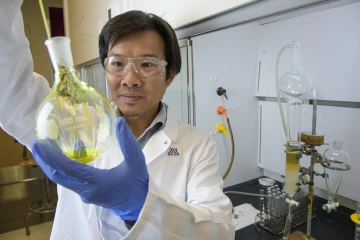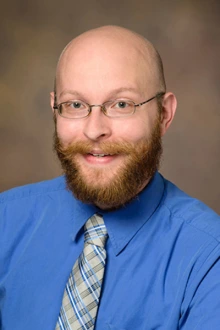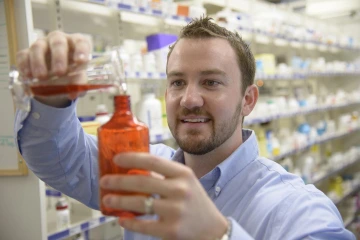Drug Discovery to Consultations: Pharmacists in a Pandemic
From a research laboratory to a hospital bedside to the neighborhood pharmacy, this profession touches all of health care in a pandemic.

Pharmacy student mixes compounded medication at the University of Arizona Cancer Center.
The COVID-19 pandemic is putting the global health care system to the test, and pharmacists around the world are being viewed as critical components in helping the public remain safe, healthy and informed.
The scientific and patient care expertise housed in the University of Arizona College of Pharmacy plays an increasingly important role in health care.
Pharmaceutical researchers and practitioners are making a difference every day, whether from behind a counter, at a bedside or in a lab at the forefront of drug discovery research with the hopes of finding a cure.
Developing Drugs to Fight the Virus
Jun Wang, PhD, assistant professor in the College of Pharmacy, has been studying respiratory viruses, including influenza, for several years. During the rise of COVID-19, his experience with antivirals allowed him to quickly transition some of his laboratory resources to focus on new projects related to the pandemic. Within two months – breakneck speed in the timeline of academic research – his lab was able to identify several promising drug candidates that inhibit SARS-CoV-2 virus in cell culture.

Jun Wang, PhD
Because of his previous work and his connection with the National Institutes of Health, Pfizer, Inc., contacted Dr. Wang to partner on testing a series of compounds against the virus that causes COVID-19.
Professor Chris Hulme, PhD, has been working for years to identify novel treatments for Alzheimer’s disease. In recent weeks, he has shifted his efforts towards COVID-19 research.
“There remains a significant knowledge gap in the precise pharmacological underpinnings of COVID-19. As such, fundamental studies of signaling mechanisms involved in disease progression are required, which is typically the strength of academic research,” explained Dr. Hulme. “The deliverables of such efforts should unveil new biological targets, which medicinal chemists would be able to engage to deliver therapeutics that are small molecules and orally bioavailable. Efforts are also continuing to repurpose safe, existing drugs, which is heavily driven by academic researchers.”
Bench to Bedside
Hospital emergency departments are often the first stop for a COVID-positive patient. As cases continue, clinical pharmacists have become more important to have on a health care team.

Christopher Edwards, PharmD
“We’re here to make sure that during a challenging situation, good therapeutic decisions are being made,” said Christopher Edwards, PharmD, assistant professor at the college and clinical pharmacy specialist in emergency medicine at Banner - University Medical Center Tucson.
Medications ordered through the hospital pharmacy are reviewed for accuracy, and then dispensed by a team of pharmacists.
“In an emergency department, there is a lot of high energy and high stress, especially during a pandemic, and having one person who is focused on the medication helps reduce the potential for errors,” said Dr. Edwards.
Clinical pharmacists, like Dr. Edwards, are providing guidance on which drugs may be considered an effective treatment for COVID-19, and which may need more scrutiny.
“Clinical pharmacists were able to quickly evaluate the quality of available evidence, determine how we should utilize our limited supply of hydroxychloroquine, for example, and what kinds of patients should get it, if any,” explained Dr. Edwards.
Embedded in the Community
Behind the counter of a local community pharmacy, Theresa Taylor, PharmD, alumna of the College of Pharmacy class of 1992, is wiping down every surface she and her team have touched.
“Pharmacies tend to have regular sanitizing procedures,” explained Dr. Taylor. “Now our efforts are heightened and intentional. I set my phone alarm to ring every 30 minutes to signal staff to wash hands and sanitize.”
Approximately 67,000 pharmacies are open across the country. More than 90% of U.S. residents live within five miles of a community pharmacy, and in rural and medically underserved communities, pharmacists often are the only health care provider immediately accessible to patients.

Pharmacy student mixing and dispensing medication at the University of Arizona Cancer Center.
In the U.S., there are an estimated 13 billion pharmacy visits each year. Frequent interaction with the general public has placed community pharmacists at the center of public health initiatives. In the midst of the current crisis, many of Dr. Taylor’s patients are turning to her for advice beyond their medication needs.
“I have received many calls since the start of this pandemic from patients seeking my opinion on what they are hearing in the media,” said Dr. Taylor “I advise people on the resources available in their community and triage to other sources of support.”
Helping people stay well or get well during a pandemic is the driving force behind what pharmacists do, whether they’re behind the counter, or behind the door of their lab.
“What is the motivation for us to come to work?” asks Dr. Wang. “Spending eight to ten hours a day, six to seven days a week in the lab? For me, the motivation is, ‘Can we make a difference?’”

